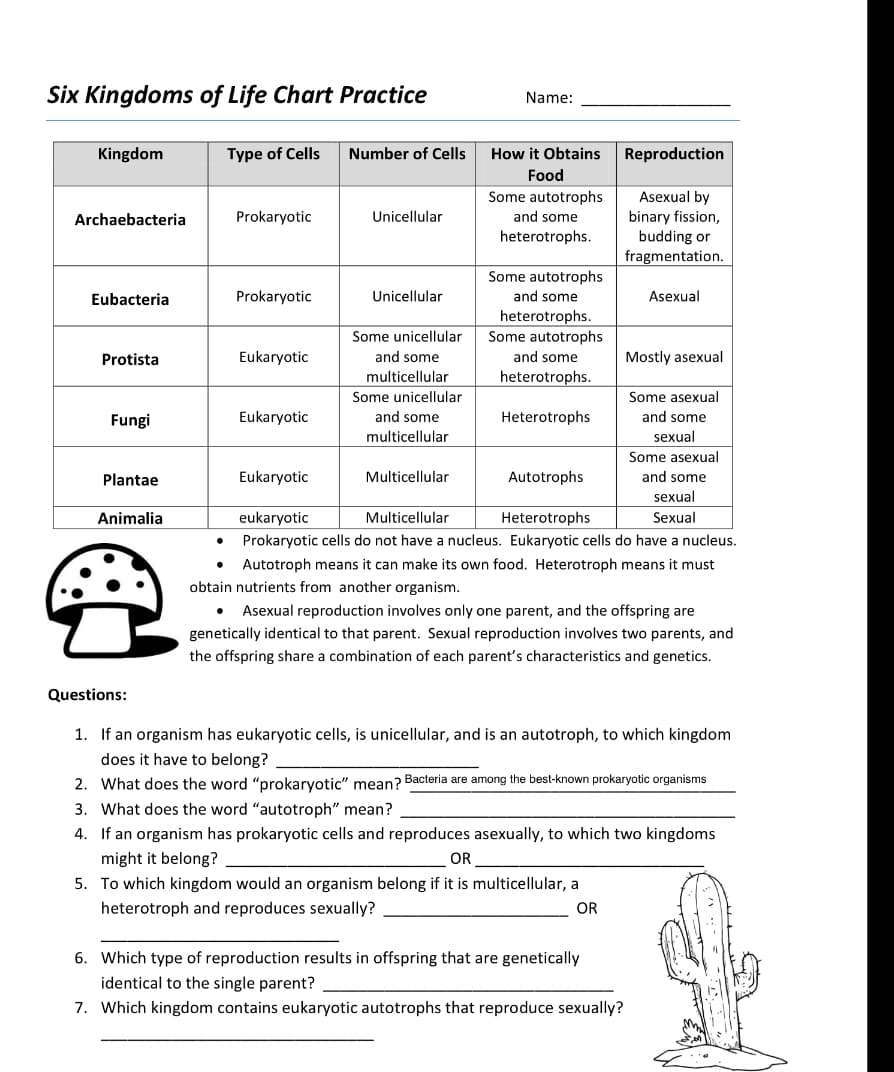Kingdom Type of Cells Number of Cells How it Obtains Reproduction Food Asexual by binary fission, budding or fragmentation. Some autotrophs and some Archaebacteria Prokaryotic Unicellular heterotrophs. Some autotrophs Eubacteria Prokaryotic Unicellular and some Asexual heterotrophs. Some unicellular Some autotrophs Protista Eukaryotic and some and some Mostly asexual multicellular heterotrophs. Some unicellular Some asexual Fungi Eukaryotic and some Heterotrophs and some multicellular sexual Some asexual Plantae Eukaryotic Multicellular Autotrophs and some sexual Animalia eukaryotic Multicellular Heterotrophs Sexual • Prokaryotic cells do not have a nucleus. Eukaryotic cells do have a nucleus. Autotroph means it can make its own food. Heterotroph means it must obtain nutrients from another organism. Asexual reproduction involves only one parent, and the offspring are genetically identical to that parent. Sexual reproduction involves two parents, and the offspring share a combination of each parent's characteristics and genetics. Questions: 1. If an organism has eukaryotic cells, is unicellular, and is an autotroph, to which kingdom does it have to belong? 2. What does the word "prokaryotic" mean? Bacteria are among the best-known prokaryotic organisms 3. What does the word "autotroph" mean? 4. If an organism has prokaryotic cells and reproduces asexually, to which two kingdoms might it belong? OR 5. To which kingdom would an organism belong if it is multicellular, a heterotroph and reproduces sexually? OR 6. Which type of reproduction results in offspring that are genetically identical to the single parent? 7. Which kingdom contains eukaryotic autotrophs that reproduce sexually?

Eukaryotes are organisms whose cells contain a nucleus (along with other membrane-bound organelles. These organisms, includes all animals, plants, fungi, and protists).
A prokaryote is a single-celled organism that doesn't have a nucleus.
The autotrophs produce their own food, they are sometimes called producers. Autotrophs are capable of producing complex organic compounds (carbohydrates, fats and proteins) using carbon from simple substances (carbon dioxide). They are capable of self-nourishment by using inorganic materials as a source of nutrients and use photosynthesis or chemosynthesis as a source of energy.
Asexual reproduction is a type of reproduction that does not involve the fusion of gametes. The offspring that arise by asexual reproduction (unicellular or multicellular organisms) inherit the full set of genes of their single parent).
Trending now
This is a popular solution!
Step by step
Solved in 2 steps






